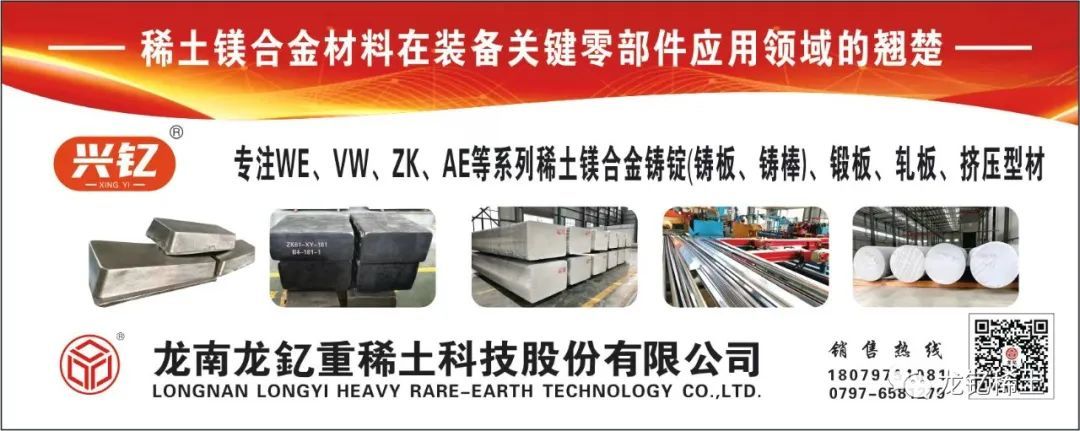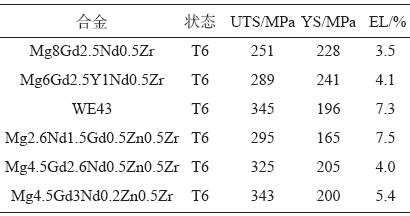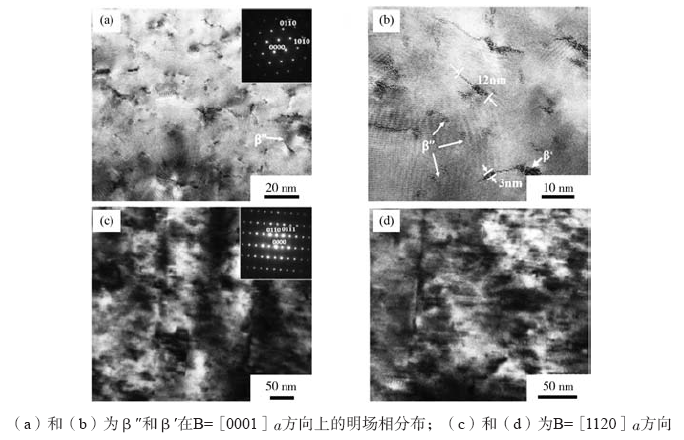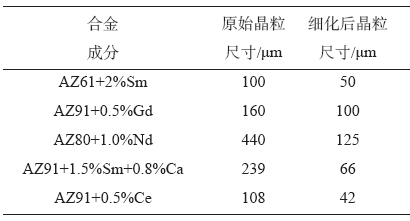10
2023
-
10
Application and Research Progress of Rare Earth Elements in Cast Magnesium Alloys
Author:
The addition of rare earth elements in cast magnesium alloys can significantly improve the process properties, mechanical properties and heat resistance of magnesium alloys. This paper systematically summarizes the application status and research progress of rare earth elements in Mg-Al, Mg-Zn and Mg-RE cast alloys, discusses the influence law and mechanism of rare earth elements on the microstructure and properties of cast magnesium alloys, summarizes the mechanical properties of cast magnesium alloys with rare earth elements, summarizes the strengthening mechanism of rare earth elements, and looks forward to the development trend and future application of high-performance rare earth cast magnesium alloys.

Magnesium alloy is one of the lightest metal structural materials in the world, with small specific gravity, high specific strength and specific stiffness, can withstand large impact and vibration loads, and has good corrosion resistance to alkali, gasoline, kerosene, benzene and mineral oil., And excellent cutting performance and polishing performance. It has broad application prospects in transportation, aerospace, automotive, medical equipment and other fields. At the same time, magnesium alloy has a significant lightweight effect and is widely used in the lightweight of military weapons and equipment, 3C and other products. However, magnesium alloys also have problems such as extremely unstable melting process, serious casting shrinkage and thermal cracking defects, poor high temperature strength, creep resistance and corrosion resistance, which limit their wide application. Rare earth elements have good solid solubility in magnesium alloys, and the addition of rare earth elements can effectively refine the grain size, significantly improve the room temperature and high temperature mechanical properties of the alloy, and the flame retardant effect is obvious during melting. Therefore, this paper summarizes the effect of rare earth elements on the tissue and mechanical properties of cast magnesium alloys, and further summarizes the strengthening mechanism of rare earth in magnesium alloys, and puts forward the idea of rare earth alloying of high-performance magnesium alloys.
Research Status of Cast Magnesium Alloy Containing Rare Earth
1.1 Mg-Al-RE magnesium alloy
Mg-Al alloys have the advantages of good casting performance and low production cost, but their low mechanical properties at room temperature and high temperature and poor heat resistance limit their application. There are continuous precipitates uniformly distributed in the matrix and discontinuous precipitates distributed in the grain boundary in the Mg-Al alloy, but the discontinuous precipitates with coarse morphology deteriorate the mechanical properties of the alloy. The addition of RE element can inhibit the precipitation of discontinuous phase and improve the high temperature mechanical properties of Mg-Al magnesium alloys. At present, AZ alloy, AS alloy, ACM alloy and other Mg-Al alloys containing rare earth elements have been developed.
After adding rare earth Sm to AZ61 alloy, the cast tissue of the alloy includes Al2Sm and Mg17Al12 phase, the grain refinement effect of rare earth alloying is significant, and after heat treatment, the mechanical properties of the alloy with 2% Sm are improved. Wang et al. explored the effect of trace Gd on the microstructure and mechanical properties of as-cast AZ91 alloy. After Gd is added, Al8Mn4Gd phase is formed in the alloy. As the particle of heterogeneous nucleation, Mg17Al12 phase is significantly refined. With the increase of Gd content, the tensile strength and elongation of the alloy are significantly improved. When Gd content is 0.5, the as-cast properties of the alloy are excellent. After Chen Lei and Wang et al. added Nd to AZ80 alloy, the coarse continuous Mg17Al12 phase turned into a fine and intermittent distribution, the alloy formed a rod-shaped Al11Nd3 phase and a massive Al2Nd phase, the rare earth phase significantly delayed the peak aging time, and the yield strength increased significantly after heat treatment.
The addition of different rare earth elements in magnesium alloy will reduce the solid solubility of each other in the magnesium matrix, improve the morphology of the precipitated phase, and enhance the strengthening effect of the alloy. Jiang et al. added rare earth Nd and Gd in AZ80 alloy. With the addition of Gd, the Al11RE3 phase in the alloy gradually changed to Al2RE phase. After Gd was added, the rare earth phase agglomerated, resulting in the decline of alloy performance.
AS alloys have good mechanical properties and creep properties, but with the increase of Si content, coarse Mg2Si phase will be formed in the matrix, which will reduce the mechanical properties of the alloy. Zhu Wenjie et al. studied the effect of Ce on the mechanical properties of Mg-5Al-2Si. Al11Ce3 and CeSi2 phases appear in the as-cast microstructure of the alloy. With the increase of Ce content, CeSi2 phase gradually increases and Al11Ce3 phase gradually decreases. The addition of Ce effectively refines the size, morphology and distribution of Mg2Si phase. When the addition of Ce is 0.4%, the room temperature mechanical properties of the as-cast alloy are the best. After LIU et al. added 0.5%Gd and 0.5%Ca to the Mg-7Al-1Si alloy, the alloy showed the smallest creep ratio, because the addition of Gd formed Al2Gd phase, the Mg17Al12 phase was reduced, and the Mg2Si phase was refined to improve the creep performance of the alloy. Table 1 shows the mechanical properties of some Mg-Al alloys and their strengthening phases.

Table 1 Mechanical properties and strengthening phases of some Mg-Al magnesium alloys
1.2 Mg-Zn-RE alloy
The maximum solid solubility of Zn in magnesium is 6.2, and the solid solubility decreases with the decrease of temperature, which is a very effective alloying element other than Al.
Solid solution and aging double strengthening effect. The precipitation sequence of the Mg-Zn alloy is: SSSS (supersaturated solid solution) → GP region → β′ 1(Mg4Zn7)→ β′ 2(MgZn2)→ β(MgZn or Mg2Zn3). Nie studied the hindrance of different precipitation relative to the base surface slip in Mg-Zn alloy, and according to Figure 1, the column disk-shaped precipitation phase of aging precipitation has the best strengthening effect, followed by the rod-shaped phase, and the base disk-shaped phase strengthening effect is the worst.

Fig.1 Schematic diagram of different precipitates in Mg-Zn alloy
Adding rare earth elements to M g-Z n alloy can improve the casting performance and creep resistance of the alloy. Z M 2 alloy is to add 0.7~1.7%Ce on the basis of (Zn = 3.5~5.0, Zr = 0.5~1.0). Dai Xiaoteng et al. studied the influence of microstructure changes of Mg-6Zn alloys with different Ce contents under heat treatment. With the increase of Ce content, the formation of Mg-Zn phase is inhibited, MgZnCe phase gradually increases, the Mg-Zn phase is completely solid-solved after solid solution treatment, Ce5(Mg,Zn)41 phase is transformed into Mg17Ce2 phase, Zn atoms are precipitated in the form of MgZn and MgZn2 phases after aging treatment, and the second phase is still Mg17Ce2 phase. Wang et al. studied the effect of adding 1.5 Ce-rich mixed rare earth to the microstructure and mechanical properties of the Mg-4.2Zn-0.7Zr alloy. After the alloy was aged at 325 ℃ for 10 h, fine and dense short rod-like β' 1 phase precipitated in the grains, and the mechanical properties of the alloy were improved. Its tensile strength, yield strength and elongation reached 247 MPa, 159 MPa and 15.6 respectively.
Zhang Jitao found that after adding rare earth Gd to Mg-5Zn-0.6Zr magnesium alloy, the coarse reticular MgZn2 phase was significantly refined, forming a 2~5 μm fine dispersed MgZnGd phase, hindering dislocation movement and improving performance. When the addition amount of Gd is 1%, the mechanical properties are the best, with tensile strength and elongation reaching 223 MPa and 7.6 respectively.
When different rare earth elements are added to Mg-Zn alloys, replacement will occur between RE elements to improve alloy properties. Zhao Yongcheng et al. added 1%, 2% and 3% rare earth Sm to Mg-6Zn-1.5Y-0.8Zr alloys respectively, and Sm replaced Y in Mg3Y2Zn3 and Mg3YZn6 respectively to form Mg3(Y, Sm)3Zn3 and Mg3(Y, Sm)Zn6 phases, which mainly exist in the latter, when the addition of Sm is 2%, the tensile strength and elongation of the alloy are increased by more than 15% compared with that without the addition of Sm. Snow White explored the effect of Nd on Mg-6Zn-1.5Y-0.8Zr alloy. Similar to the addition of Sm, the addition of Nd also replaced Y in Mg3Y2Zn3 and Mg3YZn6 to form Mg3(Y, Nd)2Zn3 and Mg3(Y, Nd)Zn6 phases, but they mainly exist in the former. Compared with the alloy without Nd, the tensile strength and elongation are increased by more than 25%.
1.3 Mg-RE alloy
Mg-RE alloy is an important direction for the development of high-performance magnesium alloys. The greater the solid solubility of RE element in magnesium alloys, the more obvious the strengthening effect, and the solid solubility of Nd, Y and Gd in magnesium increases in turn. There are four stages of aging precipitation of Mg-Gd alloys: α-Mg→β″(DO19)→β′(COBC)→β1(FCC)→β(FCC). Zhou Liping and others explored the aging precipitation behavior of Mg-12Gd alloy, the main precipitation phase is the beta phase, with the increase of aging time, the size growth rate of the precipitation phase slows down, the hardening effect of the alloy first strengthens and then weakens, after aging at 225 degrees C for 16 h, the alloy has the best strengthening effect at this temperature. The addition of a variety of rare earth elements to the Mg-Gd alloy at the same time improves the strengthening effect of the alloy significantly, such as GN, VW alloy. VW alloy is the use of rare earth Y instead of part of Gd, aging process precipitation of a large number of β' phase, the tensile strength and yield strength of the alloy increased significantly, but the elongation of the alloy is low. GN alloy is the use of light rare earth Nd instead of part of Gd, aging process precipitation DO19 structure of the beta "phase, alloy hardening effect is significant, but the toughness decreased, compared to VW alloy, its yield strength is lower. The reason for the strengthening of Mg-Y alloys is also the formation of the beta "metastable phase of the DO19 structure, and its typical commercial grades are WE43.
Adding a small amount of Zn to the Mg-RE alloy can increase the elongation of the alloy and improve the weldability of the magnesium alloy. ZM6(Nd = 2.0%~ 2.8%,Zn = 0.2%~ 0.7%,Zr = 0.4%~ 1.0%) is a typical Mg-Nd cast magnesium alloy. Ai Jiang explored the effect of Nd on the mechanical properties of ZM6 alloy, after adding Nd, the alloy tissue was refined, the grain boundary precipitation Mg12(Nd, Zn) phase, with the increase of Nd, the hardness and tensile strength of the alloy increased, when the Nd content exceeded 3%, the room temperature tensile strength began to decline. After Zhan et al. added 1.5%Gd to the Mg-2.6Nd-0.5Zn-0.5Zr alloy, the thermal stability of Mg12Nd phase was improved. After solid solution aging treatment, the precipitation phase in the crystal increased obviously. After adding 4.5%Gd, Mg12Gd and Mg3Gd phases appeared in the alloy microstructure. After solid solution at 530 ℃ for 8 h, most of the eutectic phase had been solid dissolved into the matrix. After aging at 205 ℃ for 16 h, the size of the strengthening phase is about 0.5~3.0 μm, which is finer than that of the as-cast alloy, and the mechanical properties are significantly improved.
Xie et al. studied the effect of Gd on the tissue performance of Mg-3Nd-0.2Zn-0.5Zr alloys, and with the increase of Gd content, the aging precipitation band in the alloy increased, the long diameter ratio of the beta "precipitation phase increased, and the volume fraction increased, as shown in Figure 2, the alloy performance was significantly improved. Table 2 is the mechanical property data of some Mg-RE alloys.
Table 2 Mechanical properties of some Mg-RE alloys


Fig.2 Matrix precipitates of alloy aged at 200 ℃ for 16 h under TEM lens
After adding a certain amount of Zn to the Mg-RE alloy, the mechanical properties and heat resistance of the alloy are improved. M. Matsuda et al. discovered a long period stacking sequence (LSPO) structure in the rapid solidification of Mg-1Zn-2Y alloys, and there are four types of stacking structures 10H, 14H, 18R, and 24R in the LPSO structure. Zn element can promote the formation of LPSO phase, and it is also the constituent element of β-series precipitated phase particles, and the LPSO phase structure hinders the growth of β-phase particles during aging. When β-series precipitated particles and LPSO phase coexist, the mechanical properties and corrosion resistance of magnesium alloy are further improved. Meng Jiao and others studied the effect of Zn on the microstructure and properties of Mg-Gd-Zn-Zr alloy, with the increase of Zn content, the volume fraction of LPSO phase also increased, the alloy performance began to decline, but the creep resistance is still higher than WE54 alloy, the preparation of the Mg-11Gd-1Zn-0.5Zr cast magnesium alloy tensile strength reached 416 MPa, elongation of 7.1. Hu Jie studied the effect of different Y content on the tissue and mechanical properties of Mg-10Gd-1Zn-0.5Zr magnesium alloy, after adding Y, the second phase formed in the alloy increased, and Y can become the core of heterogeneous crystallization, hindering the growth of grain, when the addition of Y increased from 1% to 2%, coarse strip-shaped Mg5(Gd, Y, Zn), lamellar Mg12(Gd, Y)Zn and LPSO phases in the alloy decrease, fishbone-shaped LPSO phases hinder grain growth, granular Mg24(Gd, Y, Zn)5 phases increase, and the tensile strength and yield strength of the alloy increase from 229 MPa and 166 MPa to 237 MPa and 189 MPa respectively. Meng Linggang's research found that when the Y/Zn ratio is less than 2.3, the second phase at the grain boundary in the as-cast state is all converted into Mg10(Gd, Y)Zn phase with LPSO structure, Mg-5Gd-2Y-2Zn-0.5Zr obtaining excellent high-temperature tensile strength of 240 MPa, which is nearly 30 MPa higher than WE43 with the same rare earth content. Nd inhibits the formation of LPSO phase in the Mg-Gd-Y-Zn-Zr alloy, the volume fraction of LPSO phase and the precipitation number of β phase particles are reduced, and the properties of the alloy are strengthened. Zhang et al. found that adding Nd to Mg-8Gd-5Y-2Zn-0.5Zr alloy can improve the mechanical properties in solid solution and aging state. With the increase of Nd content, the grain size decreases first and then increases, LPSO phase decreases significantly, and Mg5(Gd, Y, Zn) phase increases. When Nd content is 0.5, the comprehensive mechanical properties of the alloy reach the best, and its tensile strength, yield strength and elongation reach 308 MPa, 252 MPa and 5.3% respectively.
Strengthening mechanism of rare earth on cast magnesium alloy
2.1 grain refinement strengthening
Metal crystal is composed of many grains, the more the number of grains per unit volume, the finer the grains, when the fine grains are subjected to external force, the plastic change is more dispersed, the plastic change is more uniform, the stress concentration is smaller, and the finer the grain boundary area, the more tortuous the grain boundary, the more unfavorable to the expansion of cracks, the mechanical properties of metal materials can be improved by refining the grain.
Grain refinement is of great significance to improve the strength and plasticity of the alloy, and there is an important relationship between the yield strength and the grain size. According to the Holpage formula:
Ps = Σ0 Kd-0.5 (1);
Where: σs is yield strength, MPa;σ0 is yield strength of single crystal, MPa;K is Taylor coefficient; D is grain size, mm. For example, after adding Gd, Sm, Nd, Ce and other rare earth elements to the Mg-Al alloy, the grain size is significantly refined and the performance is significantly improved. After adding 1.5%Sm and 0.8%Ca to AZ91 alloy, the as-cast grain size decreased from 239 μm to 66 μm, and the as-cast microstructure was significantly refined. After adding 0.5%Ce to AZ91 alloy, the grain refinement effect is remarkable, and the grain size is reduced from 108 μm to 42 μm. Table 3 shows the grain refinement effect of common rare earth elements on Mg-Al alloys.
Table 3 Effect of rare earth on grain refinement of Mg-Al alloy

2.2 heat treatment strengthening
When the alloy element is dissolved into the α-Mg matrix, its atomic radius and elastic modulus are different from the matrix element, and the matrix will produce lattice distortion and hinder the dislocation movement, which is called solid solution strengthening. When the solid solubility of alloying elements in the matrix changes with temperature, the strengthening phase is precipitated from the matrix, also known as aging strengthening. After aging treatment, the strength of the cast magnesium alloy is improved, the elongation is reduced, and the aging strengthening effect is related to the size, shape, volume fraction, hardness and the relationship with the matrix. Zhang Yu studied the heat treatment process of the new Mg-6Zn-2Sm-0.4Zr alloy. After solution insulation at 450 ℃ for 28 h, the eutectic phase at the grain boundary gradually dissolves, and the grain size increases obviously with the increase of solution time. The mechanical properties of the aging insulation process at 200 ℃ show a trend of first increasing and then decreasing with the increase of insulation time. The peak aging is reached at 12 h, the tensile strength reaches 258 MPa, and the elongation is 14.4. Gu et al. studied the effect of two-stage aging heat treatment process on the microstructure and properties of EV31 alloy. Compared with single-stage aging at 200 ℃, the holding time of two-stage aging was reduced from 16 h to 2 h, the size of precipitated phase was reduced by 50%, and the precipitated density was doubled. As shown in Figure 3, the tensile strength was increased from 273 MPa to 288 MPa, and the elongation was increased from 4.9 to 6.6.

Fig.3 STEM image of β′ phase distribution under aging treatment
2.3 dispersion strengthening
Alloy melt in the solidification will precipitate dispersion distribution of high melting point compound phase, in the grain is dispersed particle or granular distribution, in the plasticity and toughness of the premise is not reduced, can significantly improve the strength and hardness of the alloy, and the smaller the particle size, the more uniform the distribution, the better the strengthening effect, is an effective means of material strengthening. According to the Orwan dislocation strengthening mechanism, when plastic deformation occurs, the dislocation line cannot directly cut the second phase particles, but under the action of external force, the dislocation line can bypass the second phase particles to form a large number of dislocation loops, the dislocation continues to proliferate, the number and density of dislocations are significantly increased, the lattice distortion in the dislocation affected area can be greatly improved, the dislocation movement resistance is increased, and the material is effectively strengthened. By controlling the morphology, size and quantity of the dispersed phase, the mechanical properties and heat resistance of the alloy can be effectively improved.
3 Summary and outlook
(1)Mg-Al cast alloys have poor high temperature performance and are prone to defects such as shrinkage and hot cracking. The effects of precipitation morphology, distribution and heat treatment process on the microstructure and properties of Mg-Al cast alloys can be studied by controlling the types and quantities of precipitated phases, and the effects of single-phase rare earth and composite rare earth addition on the microstructure and heat resistance of alloys can be analyzed to expand the application range of Mg-Al cast alloys.
(2) The addition of RE elements in Mg-Zn casting alloys can significantly refine the grain size and improve the mechanical properties of the alloy, but the single heat treatment process fails to give full play to the beneficial effects of rare earth elements. The addition of composite rare earth elements combined with systematic precision heat treatment process can significantly improve the mechanical properties and high temperature properties of the alloy materials, and significantly improve the microstructure of the cast state, greatly reduce the production cost and shorten the manufacturing cycle.
(3) The addition of high-content RE elements in Mg-RE cast alloys aggravates the occurrence of segregation defects, and the formation of beneficial LPSO phase in Mg-RE cast alloys can significantly improve the comprehensive mechanical properties of the alloy by using composite rare earth addition process combined with alloy composition and solidification cooling rate regulation. A co-controlled coupling model of microstructure-composition-properties of Mg-RE cast alloys is constructed, it provides process support for the development of high-strength, high-toughness, heat-resistant and corrosion-resistant Mg-RE casting alloys and products.
Source: Foundry Magazine 202304
Disclaimer: This article is reproduced on the Internet and is copyrighted by the original author. Only indicate the source of reprint, such as the wrong source, involving copyright issues, please contact us, we will be the first time to negotiate copyright issues or delete the content. The content is the original author's personal opinion and does not mean that this public number is responsible for its authenticity.
Summary of Common Metal Forming Process
2023-10-12









